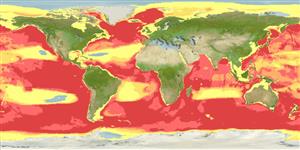Common names from other countries
Environment: milieu / climate zone / depth range / distribution range
Οικολογία
Πελαγικό(ά); ωκεανόδρομο(ς) (Ref. 75906); εύρος βάθους 80 - 500 m (Ref. 1005). Polar; 90°N - 90°S, 180°W - 180°E
North Atlantic and North Pacific: Balaenoptera musculus musculus.
North Atlantic [IUCN 2010 (Ref. 84930): VU, D1] and North Pacific [IUCN 2010 (Ref. 84930): LR/cd.
Length at first maturity / Μέγεθος / Βάρος / Age
Maturity: Lm ? range ? - ? cm Max length : 3,300 cm TL αρσενικό/απροσδιόριστο; (Ref. 99323); μεγ. δημοσιευμένο βάρος: 160.0 t (Ref. 1394)
The largest whales of the world's oceans. They can be seen from the equator to the pack ice edges in both hemispheres, with most poleward intrusions in both hemispheres in summer. Some are resident, others are migratory. Feeds on krill (Ref. 1394). Feeds at depths less than 100 m (Ref. 1005). From the time faster catcher boats and explosive harpoons made them catchable, blue whales were hunted relentlessly from the late 19th through the mid 20th centuries. As the largest whales, they were the most sought after of the rorquals. Although most populations remain well below pre-exploitation levels, some stocks (such as those that feed off California) have shown encouraging signs of recovery since protection by the International Whaling Commission (IWC) in 1965. At least in the eastern North Atlantic and the eastern North Pacific, numbers appear to be on the rise (Ref. 1394). In general, they occur in coastal, shelf, and oceanic waters (Ref. 122680). They can be seen from the equator to the pack ice edges in both hemispheres, with most poleward intrusions in both hemispheres in summer. Some are resident, others are migratory (Ref. 1394). Known as 'gulpers,' feeding in separate events, often lunging at large schools of fish (Ref. 122680). Feeds on krill (Ref. 1394). Feeds at depths less than 100 m (Ref. 1005).
Jefferson, T.A., S. Leatherwood and M.A. Webber. 1993. (Ref. 1394)
IUCN Red List Status (Ref. 130435)
CITES status (Ref. 108899)
Human uses
αλιεία: Εμπορικό(ά)
FAO - αλιεία: landings, species profile | FishSource | Η θάλασσα γύρω μας
Εργαλεία
Διαδικτυακές πηγές
Estimates based on models
Preferred temperature
(Ref.
115969): 0.2 - 3.3, mean 1.6 (based on 32832 cells).
Ελαστικότητα
Χαμηλό, ελάχιστος χρόνος για διπλασιασμό πληθυσμού 4,5 - 14 έτη (K=0.08-0.09; tm=11).
Vulnerability
Very high vulnerability (79 of 100).
Price category
Unknown.
